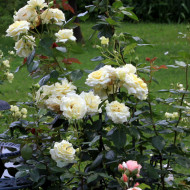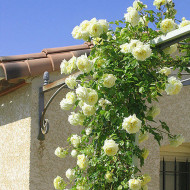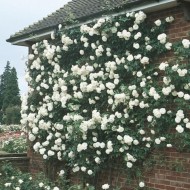Growing a climbing rose Elf: the secrets of planting and caring for the variety
Content
History of creation
The cultivar with the fabulous name Elfe was bred in Germany in 2000 by the well-known company Tantau, which has been specializing in the selection of roses for over a hundred years. The novelty immediately attracted the attention of gardeners and experts, who highly appreciated it at numerous exhibitions.
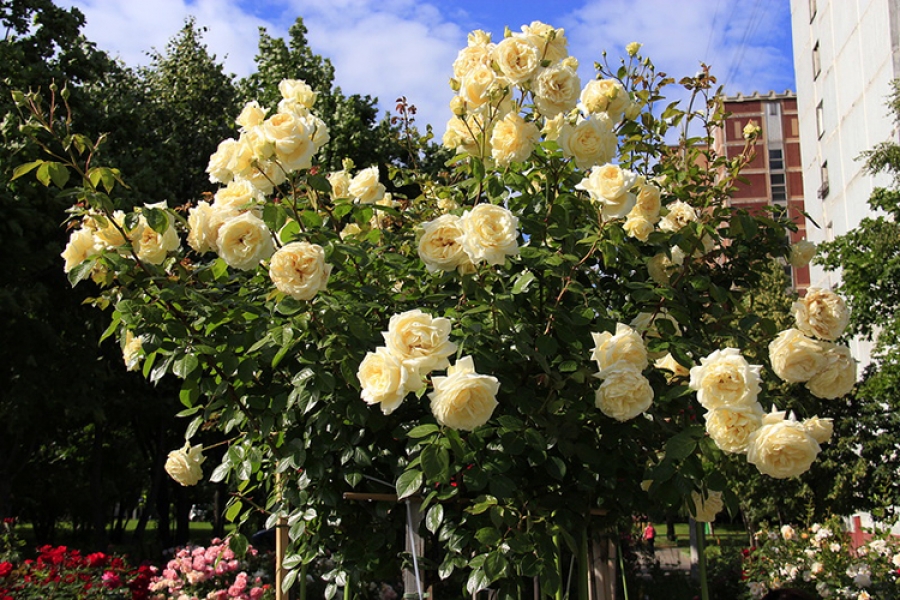
Over the years, the company has already bred several varieties with similar names, but they did not have such popularity. The new Elfe hybrid, unlike the previous ones, impressed not only with the beauty of the buds, but also with its resistance to diseases such as black spot and powdery mildew, which is very important for roses..
Description of the variety
The rose belongs to the subgroup of climbers, so its shoots are tougher and rougher than that of classic climbing roses. The bush is powerful, vigorous, reaches a height of 2-2, 8 m, grows in width by 1, 5 m. There are many branches, they intertwine and bend down under the weight of numerous buds. The color of the bark is reddish, with thorns on the surface. The foliage is dark green, glossy.
The flowers are formed by loose racemes consisting of 3-7 large (about 15 cm) buds of a delicate white color with a yellowish-creamy center. Examining the bud, it can be noted that in its external description and structure it looks like a Delphi tea hybrid - the same graceful, but whiter terry due to the large number of petals.
The bush begins to bloom for 2 years. The flowering is undulating, lasts almost all summer. The buds retain their attractiveness for a long time and exude a pleasant aroma with hints of citrus and vanilla. The plant loves the sun, but is extremely resistant to low temperatures - it can withstand frosts down to -29 ° C.

Advantages and disadvantages
After examining the reviews of gardeners, there are several pros and cons of a rose.
- beautiful buds suitable for cutting;
- delicate pleasant aroma;
- attractive bush appearance;
- long flowering;
- high winter hardiness;
- the possibility of various applications on the site;
- resistance to major diseases and insects.
- flowers do not tolerate rain well, get wet and lose their shape;
- exactingness to lighting - in the shade, the buds become smaller and are formed in fewer quantities;
- capriciousness - with the same care, the bush blooms well in one year, in another it does not.
Video "Review of the Rose Elf"
This video examines the main varietal characteristics of a climbing rose.
Landing
In the southern regions, a rose can be planted in spring or autumn, in the northern and middle lane - only in spring, since the seedlings can freeze in the first year. In order for the climbing beauty to reveal its potential, a sunny site with good fertile land is selected for her, in which moisture does not stagnate.
A hole is dug to a depth of 0.5-0.6 m, drainage from crushed stone is laid on the bottom, then fertilizers (compost, humus layer 10 cm), top - a layer of earth.The day before planting, the roots of the seedlings are soaked in "Heteroauxin", then planted in the standard way. When planting several bushes, it is recommended to adhere to a distance of 0.5-1 m between them.
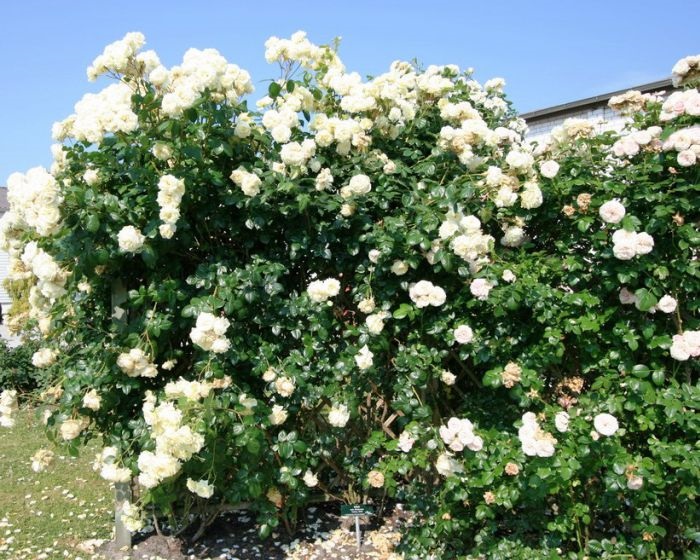
Plant care
Throughout the growing season, the rose needs competent care, consisting of the activities described below.
Watering
Despite its resistance to drought, the rose needs to be watered regularly during the flowering period. In dry weather, watering is done about 2 times a week. By the end of summer, the frequency decreases, and in September they stop altogether. The plant does not like dry air, therefore it is recommended to spray it with warm water in the summer. It is better to do this in the evening so that the drops on the leaves do not cause a burn.
Top dressing
Top dressing promotes good flowering, so they feed the bush every 2-3 weeks.
- Nitrogen is added in early spring.
- Before flowering and later until the end of July, a mineral complex is used in combination with organic matter (compost, humus in the form of mulch).
- Since August, feeding is stopped so that the plant has time to prepare for wintering.
Pruning
Formative pruning is carried out from the second year in the spring. Sanitary pruning can be done at the end of the season if necessary. The plant easily takes the desired shape, so the crown can be cut in accordance with the idea. In this case, it is necessary to remove all small unproductive and damaged shoots. Typically, 6-7 buds are left - such pruning is considered medium and promotes abundant flowering.
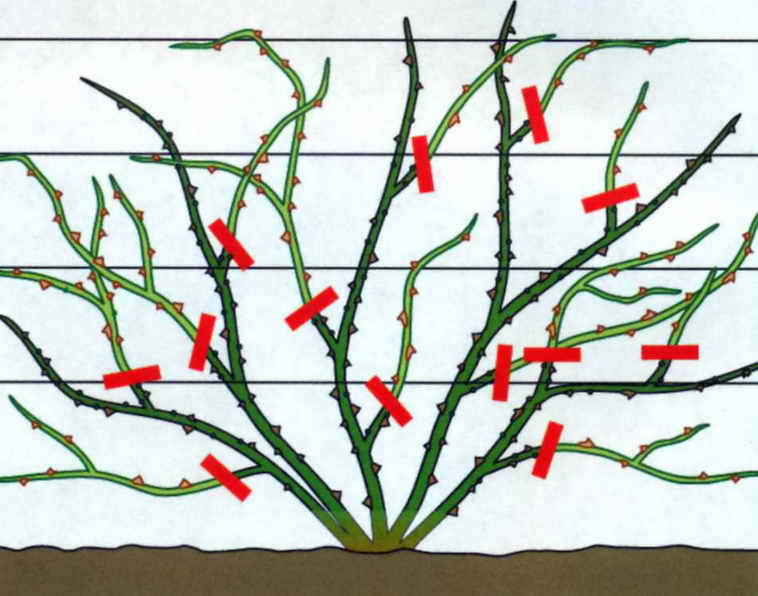
Loosening and mulching
If the near-trunk zone is not mulched, loosening of the soil should be carried out after each watering. However, it is more convenient to use mulch - it will eliminate the need for weeding and frequent watering, and will also give an aesthetic appearance. Decorative wood chips, fine gravel will add completeness to the garden. The list of care measures also includes providing the plant with a support that will support the flowering branches and give them a vertical direction.
Preparing for winter
The elf is considered a winter-hardy variety, but so that young shoots do not freeze, it is recommended to cover the bush. This is done only with the onset of stable frosts, reaching 5-7 ° C below zero. Before this, the rose must be cut off, the roots must be covered with earth, sprinkled with humus or compost, then the lashes must be removed from the support and laid on a wooden flooring. From above, cover with spruce branches or build a frame shelter. In the northern regions, roses winter comfortably just under the snow.
The shoots of the rose are thick, if you bent them sharply, they will break. To prevent this from happening, bend the branches down gradually over several days.
Reproduction
You can propagate a rose in 2 ways - by seeds and cuttings.
Seeds
The method is laborious and is used mainly for breeding new varieties. The seeds are calibrated, dipped in hydrogen peroxide for half an hour, then laid out on a moistened cloth and placed in the refrigerator for 1, 5 months. Periodically, the tissue with the seeds is ventilated and moistened again until sprouts appear. The seeds are then planted in peat pots and grown as seedlings.
Cuttings
Cutting is a more productive and reliable way, which gives almost 100% rooting and preservation of varietal traits. Cuttings are cut from young green shoots. The lower cut is made at an angle of 45 °, the upper cut is straight. Cuttings are planted in a moist substrate and greenhouse conditions are created. After the appearance of the first leaves, they are transplanted to a new place.
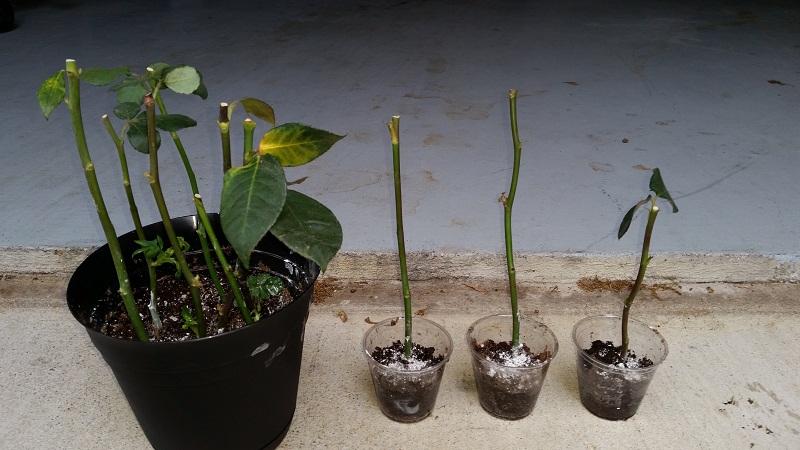
Diseases and pests of the variety
As already noted, roses have a good immunity to powdery mildew, but during periods of prolonged rains, white powdery spots may appear on the leaves. To stop the development of the disease, roses are sprayed with copper-containing fungicides.
Another dangerous disease of roses is bark cancer. Signs of the disease are brownish color and growths on the shoots. In this case, it is important to remove diseased branches in time. If most of the bush is affected, it is simply dug up and burned.
Of the pests, the most harmful are leaf rodents - bronzes, aphids, spider mites. Systemic insecticides help to cope with them: "Confidor", "Actellik".
Use in landscape design
The plant lends itself well to shearing, which allows it to be planted not only in tall architectural forms, but also in flower beds. The majestic bush looks good in a frame of small flowers of light shades: lavender, verbena, as well as undersized conifers.
The most successful way to use a rose is, of course, vertical gardening. With flexible lashes, you can beautifully decorate a fence, wrap around a column or a corner of a wall, a gazebo. The airy white "cloud" of roses looks bright against the background of the emerald lawn. A flower is also good in cut - florists use barely opened buds in wedding bouquets.
- Garden decoration
- Arches decoration
- Wall decoration
- Decorative composition element
- Decorating a recreation area in the garden
Reviews
“I didn’t dare to plant this rose for a long time, I thought it was difficult to care for it. However, she made me happy - it blooms all summer, never got sick with anything. "
"I really wanted to plant the same beauty, I love white roses."
“And my rosette is still small, but it has grown well over the first summer. We are waiting for flowering. "
With this rose, the atmosphere on the site will become more romantic. A tall flowering bush will fill it with freshness, pleasant energy and delicate aroma.

